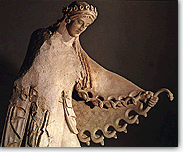







     | |
  |
|
|
Athens: In the Acropolis, many Archaic architectural sculptures made of limestone , bearing a painted stucco were found. Although their destruction date has not been ascertained, it is probable not to be coincidental with the Persian pillage of the Acropolis, but to the removal -after the fall of tyranny |  |
Delphi: The temple of Apollo in Delphi was built by the Alcmaeonidae family under contract from the sanctuary. Very few parts |
Aegina:
The great temple of Aphaia in Aegina was built around the end of the |
|
| |
|
Note: Click on picture for short description. | |